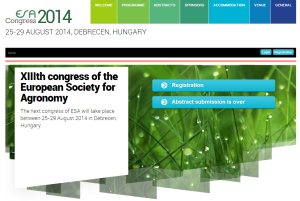European Society for Agronomy, an open forum for agronomists, researchers, teachers and students who are concerned with basic and applied science in agronomy: the relationships between crops, soils, climates and agricultural practices, and between agriculture and the environment, will organize the 8th ESA Congress – hosted by the Centre for Agricultural and Applied Economic Sciences of the University of Debrecen, Hungary between 25-28 August 2014.
Main objectives of the congress program include:
- to introduce the latest scientific results in all the three divisions of the congress
- to identify new scientific trends and put forward recommendations to political decision-makers
- to promote scientific collaboration and improve cooperation activities
- to give an overall picture of Hungarian plant cultivation and present the research activities in the fields of plant cultivation and other interdisciplinary fields which are carried out at the University of Debrecen
- to facilitate the integration of researchers from Central and Eastern European countries into the ESA
Jon Lizaso, Professor at the Technical University of Madrid (ETSI School of Agricultural Engineering, Department of Phytotechnics; one of the core DSSAT Development Team), will give a keynote speech:
ESA Congress Website
IMPROVING CROP MODELS: INCORPORATING NEW PROCESSES, NEW APPROACHES, AND BETTER CALIBRATIONSCrop models simulate main processes associated to growth, development, and production. By quantitatively describing complex bio-physical mechanisms, these tools allow enhanced understanding and management of cropping systems. Comprehensive crop models appeared in the 70’s and 80’s and many of them evolved into our current models. Other models have a more recent history. The quest to improve models keeping pace with new scientific questions and public expectations, has been paralleled by the need to maintain equilibrated modules and restrict input requirement. This talk will discuss the need to continue improving crop models by adding the simulation of new processes or by implementing new approaches. Examples will illustrate both cases. Special emphasis will point to the need to preserve field experiments and data collection to develop improvements and to calibrate model performance across a wide range of environments.


